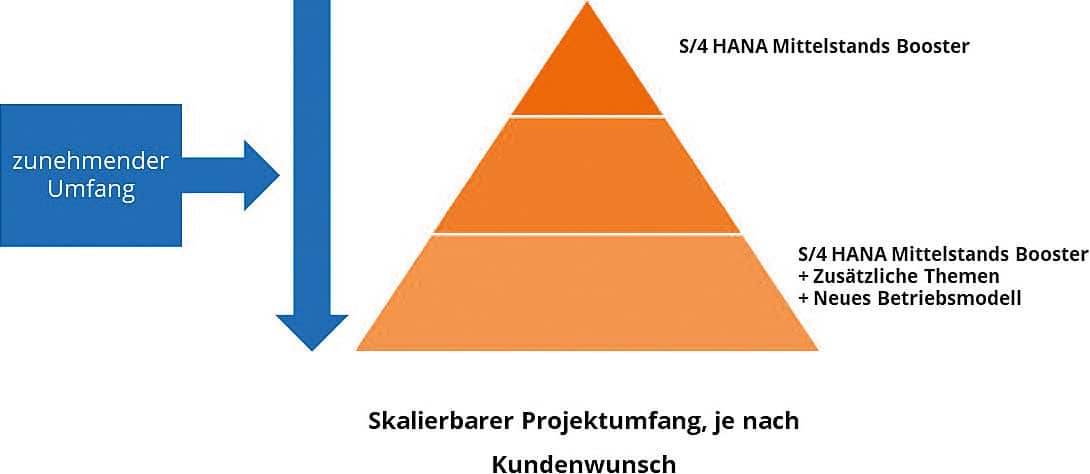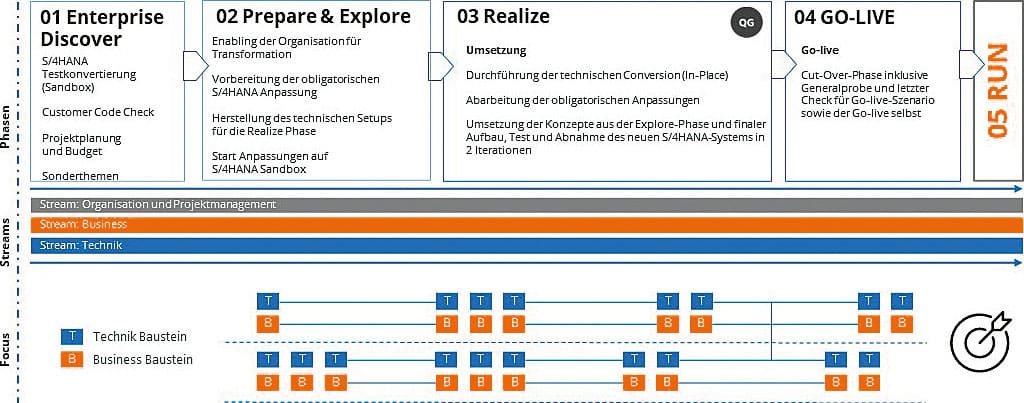S/4 Midmarket Booster


S/4 Brownfield: Convert ECC 6.0 to S/4 Hana as a whole or in two steps
In this process, the mandatory changes are brought into the system at the same time. Adesso Orange has been involved with this approach, among others, since the beginning of the S/4 history. What we notice again and again is that there are knowledge gaps among existing SAP customers, especially due to the operational business. There is a lack of time to deal with S/4 Hana and all implementation approaches. This in turn leads to uncertainty as to how the topic should or could be approached.
The whole thing is additionally accompanied by time pressure, as the S/4 transition must be completed by the end of 2027 (2030 in Extended Support). Extensive strategy and analysis workshops are often conducted, with the result that the brownfield approach seems to be the right one for the company. However, the extensive workshops result in high expenses for companies. At the same time, it is quite easy to decide the approach in a directional way with two central questions.
Are the SAP users in the company satisfied with the business processes currently supported by SAP solutions and do they also want to continue the current process logic with S/4 Hana? Does the IT department get the maintenance of the current SAP solution implemented satisfactorily as well as cost-effectively and has little technical or data-related ballast?

If he answers "yes" to both questions, the SAP existing customer is most likely a brownfield type! Of course, there are companies with complex IT system landscapes that have to approach the topic strategically and supported by analyses. However, if a system landscape consists of an SAP ERP, possibly one or two other SAP product solutions, and some connected third-party solutions or warehouse technology, this is not immensely complicated from the perspective of the S/4 transition approach. There is therefore no need for lengthy and expensive strategy and analysis workshops before a reliable time and cost indication is available.
Go-live in a few days
As a rule, one plans the one-step conversion in terms of go-live in three to four days. But what if situations arise that were not foreseen and the conversion, and thus the whole project, gets out of hand?
Testing in advance seems to be the solution. Nevertheless, a conversion already requires S/4 knowledge, basic S/4 licenses (flat fee) and possibly, depending on the situation, also an available NetWeaver 7.5x as well as hardware suitable for S/4 Hana. In other words, quite a bit of equipment and investment to even begin testing. Adesso Orange has derived an S/4 procedure with its own process model (Active Transformation) to avoid this dilemma.
The idea of this approach is that SAP existing customers convert the ERP system to S/4 in a test. The SUM (Software Update Manager) logs any problems that come up during the conversion. These are then solved and documented as tasks for the actual conversion project.
After the test conversion, SAP users have an S/4 system with their processes, data and customer developments in which about 60 to 70 percent of the processes are running and can be tested. This means that customer developments can also be tested for runnability. The findings are then used to create a project plan with budget planning for the real S/4 conversion. If required, Adesso Orange also provides the necessary S/4 Hana infrastructure and licenses.
During the conversion to S/4, there are a number of new functions and processes that can be used. Essentially, these are the new processes and functions in internal and external accounting with the biggest change for SAP users. In the logistics area, there are generally only minor issues. Almost all logistics processes continue to run in S/4 and some in a compatibility mode. It is not mandatory, for example, to convert the WM module to eEWM or Logistic Execution Transport (LE-TRA) to SAP TM.

This gives companies the option of converting the new processes only at a later point in time after the S/4 conversion at their leisure until the end of 2027, if this is necessary. This means that the project scope and budget for the actual S/4 transformation can be reduced to what is necessary, and the project duration can also be significantly shortened as a result.
Of course, if necessary, it is possible to implement one or the other new process during a brownfield conversion. However, it is advisable not to let this get out of hand. As a rule, it is more efficient to first get to grips with S/4 technically and then innovate at your leisure. Before you start the actual conversion project, there are still some important and preparatory measures in SAP ERP.
A decision is needed as to whether the "New General Ledger", already available on ECC 6.0, will bring a benefit to the company or not. If there is a benefit, the changeover should be implemented in ECC in order to give the SAP users from the specialist departments the opportunity to already get used to this process change. If there is no benefit, it should be combined with the S/4 conversion, since the conversion can then be carried out without changing processes and thus without extensive concepts.
As a business partner, you need to switch to the new business partner structure in SAP ERP. This is not witchcraft and is very well supported by SAP standard tools. This leaves the cleanup of master data. Adesso Orange also has a detailed process model for this and, with CVI Q-Check, a tool to support you.
It is important to make internal and external accounting aware of the changes in S/4. A FiCo awareness workshop is recommended. In this way, a technically driven project often becomes a business-driven project and the users are prepared for the process-related changes. Additionally, topics in the area of logistics can be added. These depend on which SAP business processes are used.
Depending on the initial situation, it makes sense to thoroughly clean up the ECC system before converting to S/4. This could be customer developments that are no longer needed or historical data that unnecessarily inflates the ERP system and should not be taken to S/4 as ballast. This is therefore a good opportunity for thorough cleaning, but of course not a must. Our recommendation for midmarket companies is to go "hands-on" to the S/4 conversion with appropriate support and not to conduct sprawling preliminary analyses and strategy workshops. Pragmatism and the sensible use of the tools and test routines provided by SAP are sufficient here. Of course, the S/4 midmarket approach can be individually extended via the Adesso Orange modular system, depending on the customer's requirements. Thus, the customer can decide at an early stage which innovations he wants to use with S/4 or introduce at a later date.
The process model shows that after the test conversion, which takes place in the Enterprise Discover phase, the S/4 brownfield transformation can be started directly. The Enterprise-Discover phase can also be carried out before the transformation project. This phase provides, in addition to other customer-specific questions, clear statements about:
- Approach to the S/4 Transformation (Roadmap)
- Process changes in the IT department and the business units (S/4 Impact)
- Handling of in-house developments and interfaces as well as other SAP or third-party applications
- Project plan for the transformation with work packages, budget, scheduling, organization, roles and resource loading
- Benefits from the S/4 transformation
- Possible IT operating models
- Maximum security for planning your S/4 transformation project
In the Enterprise-Discover project phase, only the necessary items are processed. The phase is supported by Adesso Transformation Accelerators created in previous projects. This means that in many cases the Prepare project phase can be started promptly. This phase benefits from the fact that a test conversion has already taken place. This means that an entire test run can be saved in the implementation phase.
Advantages of the booster:
- No lengthy deployment investigation and analysis workshop costs.
- No effort to make the S/4 readiness check functional (often extensive notes still need to be imported to make it run).
- No necessary investments in hardware or licenses in advance of the S/4 conversion project.
- Low demand on the customer's IT or business departments during the S/4 test conversion.
- Clear and secure budget and time planning for the S/4 conversion project.
- The ERP system is available with all processes and data as well as customer developments in S/4.
- Detailed documentation of all steps, activities and their results during the S/4 test conversion.
- The test-converted system can also be used to create more complex project modules.
(e.g.: complex in-house developments or conversion/adaptation of forms) already in the run-up to the S/4 Brownfield Transformation project, which leads to a further streamlining of the project. - Creation of a foundation to unlock further S/4 innovations at leisure after the transition.
- Minimal organizational change means that the new system can be restored immediately after go-live.
can efficiently support your business processes. - High flexibility in the project, as the test-converted system can be kept as a sandbox if desired.





